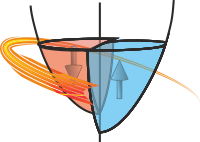Data.scale¶
- Data.scale(other, xcol=None, ycol=None, **kargs)¶
Scale the x and y data in this DataFile to match the x and y data in another DataFile.
- Parameters:
other (DataFile) – The other instance of a datafile to match to
- Keyword Arguments:
xcol (column index) – Column with x points in it, default to None to use setas attribute value
ycol (column index) – Column with ypoints in it, default to None to use setas attribute value
xmode ('affine', 'linear','scale','offset') – How to manipulate the x-data to match up
ymode ('linear','scale','offset') – How to manipulate the y-data to match up.
bounds (callable) – Used to identiyf the set of (x,y) points to be used for scaling. Defaults to the whole data set if not speicifed.
otherbounds (callable) – Used to detemrine the set of (x,y) points in the other data file. Defaults to bounds if not given.
use_estimate (bool or 3x2 array) – Specifies whether to estimate an initial transformation value or to use the provided one, or start with an identity transformation.
replace (bool) – Whether to map the x,y data to the new coordinates and return a copy of this AnalysisMixin (true) or to just return the results of the scaling.
headers (2-element list or tuple of strings) – new column headers to use if replace is True.
- Returns:
(various) – Either a copy of the :py:class:Stoner.Data` modified so that the x and y columns match other if replace is True, or opt_trans,*trans_err*,*new_xy_data*. Where opt_trans is the optimum affine transformation, trans_err is a matrix giving the standard error in the transformation matrix components and new_xy_data is an (n x 2) array of the transformed data.
Example
"""Example of using scale to overlap data.""" from numpy import linspace, sin, exp, pi, column_stack from numpy.random import normal, seed import matplotlib as mpl from tabulate import tabulate from Stoner import Data seed(3) # Just fix the random numbers to stop optimizer warnings mpl.rc("text", usetex=True) x = linspace(0, 10 * pi, 201) x2 = x * 1.5 + 0.23 y = 10 * exp(-x / (2 * pi)) * sin(x) + normal(size=len(x), scale=0.1) y2 = 3 * exp(-x / (2 * pi)) * sin(x) - 1 + normal(size=len(x), scale=0.1) d = Data(x, y, column_headers=["Time", "Signal 1"], setas="xy") d2 = Data(x2, y2, column_headers=["Time", "Signal 2"], setas="xy") d.plot(label="1$^\\mathrm{st}$ signal") d2.plot(figure=d.fig, label="2$^\\mathrm{nd}$ signal") d3 = d2.scale(d, header="Signal 2 scaled", xmode="affine") d3.plot(figure=d.fig, label="1$^\\mathrm{st}$ scaled signals") d3["test"] = linspace(1, 10, 10) txt = tabulate(d3["Transform"], floatfmt=".2f", tablefmt="grid") d3.text(10, 4, "Transform\n{}".format(txt), fontdict={"size": "x-small"}) np_data = column_stack((x2, y2)) d4 = d.scale( np_data, header="Signal 2 scaled", xmode="affine", use_estimate=True ) d4.plot(figure=d.fig, label="2$^\\mathrm{nd}$ scaled signal") d4.ylim = (-7, 9) txt = tabulate(d4["Transform"], floatfmt=".2f", tablefmt="grid") d4.text(10, -7, "Transform\n{}".format(txt), fontdict={"size": "x-small"}) d4.title = "Scaling Example"

